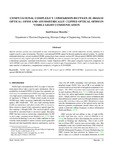Please use this identifier to cite or link to this item:
https://elibrary.khec.edu.np/handle/123456789/692Full metadata record
| DC Field | Value | Language |
|---|---|---|
| dc.contributor.author | Shrestha, Sunil Kumar | - |
| dc.date.accessioned | 2024-02-06T11:11:32Z | - |
| dc.date.available | 2024-02-06T11:11:32Z | - |
| dc.date.issued | 2023 | - |
| dc.identifier.uri | https://doi.org/10.3126/jsce.v10i1.61013 | - |
| dc.description.abstract | Optical wireless systems are constrained to send real and positive values to the optical transmitter as only intensity of a signal is used to carry information. Therefore, conventional OFDM cannot be directly applied in optical systems. To combat multipath distortion, several modified OFDM systems have been studied, such as DC-biased optical OFDM (DCO-OFDM) and asymmetrically clipped optical OFDM (ACO-OFDM). In order to transmit real signal in optical environments, there is a Hermitian symmetric constraint with Discrete Fourier Transform (DFT). This paper compares transceiver complexity of ACO-OFDM with that of DCO-OFDM which is used in Visible Light Communication (VLC), and it is found that for the same number of subcarriers, computational complexity is higher in ACO-OFDM. | en_US |
| dc.language.iso | en_US | en_US |
| dc.subject | Visible light communication (VLC), DC-biased optical OFDM (DCO-OFDM), Asymmetrically clipped optical OFDM (ACO-OFDM) | en_US |
| dc.title | COMPUTATIONAL COMPLEXITY COMPARISON BETWEEN DC-BIASED OPTICAL OFDM AND ASYMMETRICALLY CLIPPED OPTICAL OFDM IN VISIBLE LIGHT COMMUNICATION | en_US |
| dc.type | Article | en_US |
| Appears in Collections: | Journal of Science and Engineering Vol.10 | |
Files in This Item:
| File | Description | Size | Format | |
|---|---|---|---|---|
| JScE10_02_Shrestha_O.pdf | 361.56 kB | Adobe PDF |  View/Open |
Items in DSpace are protected by copyright, with all rights reserved, unless otherwise indicated.
